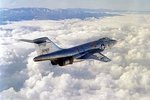davparlr
Senior Master Sergeant
drgondog=Good catch. You are right about the 102. I was disconnected there because it was first applied to 102 design (after flight test) because of dramatic difference in actual performance with 102 body versus predicted performance. The F106 was the first production ship using whitcomb area rule.
Whitcomb first tested the 'area rule' in a NACA wind tunnel in 1952. By the time of his eureka the 100 was in production and the 102 had not flown yet but was in advanced design. The first flight of the 102 was in late 1953 and by that time the F-104 design was nearly finished - ditto F-105 so they were too late to fix
Area rule is apparent on the F-105 as seen by the swelling of the fuselage aft of the wing (no, this is not because of the engine size). It is less apparent on the F-104, but sources have indicated it was designed to area rule requirements.


